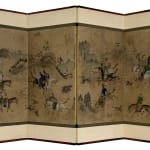





Unknown, Joseon Dynasty (1392–1897)
31 7/8 x 63 3/8 in
Further images
Hunting emerged as a popular subject for narrative paintings during the eighteenth and nineteenth centuries amongst the Joseon elite. Hunting scenes were mainly depicted on folding screens and were especially favoured by military officials of the yangban class as it showcased the skill and bravery of hunters.
This screen painting depicts Manchurians hunting a tiger and other animals in a mountain landscape. Known as “barbarians hunting” (胡獵圖), these paintings reflect the hunting customs of ethnic groups from northern and northeastern China. During the Qing Dynasty (1644-1912), court painters often depicted hunting scenes, including those featuring the emperor. In Joseon Korea, the tiger hunting theme was likely popularised by Kim Hong- do, an esteemed court painter of the late 18th century.
In contrast to its counterparts, where high-ranking Manchu officials typically enter the scene from one side of the composition, in this particular depiction, we see these officials appearing on both sides of the painting, lending a sense of balance and expansiveness to the narrative. Though the painting was initially conceived as a unified whole and subsequently divided into sections, each segment depicts distinct stages of the battle. Beginning from the right and progressing leftward, we witness a meticulous unfolding of events. The fourth screen marks the officials’ entrance into the scene. While screens two and three portrays the hunters’ unwavering determination as they engage in rigorous tiger hunting. Finally, the first screen marks the culmination of their efforts—a triumphant departure. Here, the officials emerge victorious, proudly bearing their trophy tiger on horseback. Each scene seamlessly flows into the next, creating a cohesive narrative that captivates the viewer’s imagination and transports them into the heart of the hunt.
Usually folding screens of this size were placed on top of document chests, known as mungap(문갑) in the study rooms of the yangbans.
Provenance
French Private CollectionJoin our mailing list
* denotes required fields
We will process the personal data you have supplied to communicate with you in accordance with our Privacy Policy. You can unsubscribe or change your preferences at any time by clicking the link in our emails.





